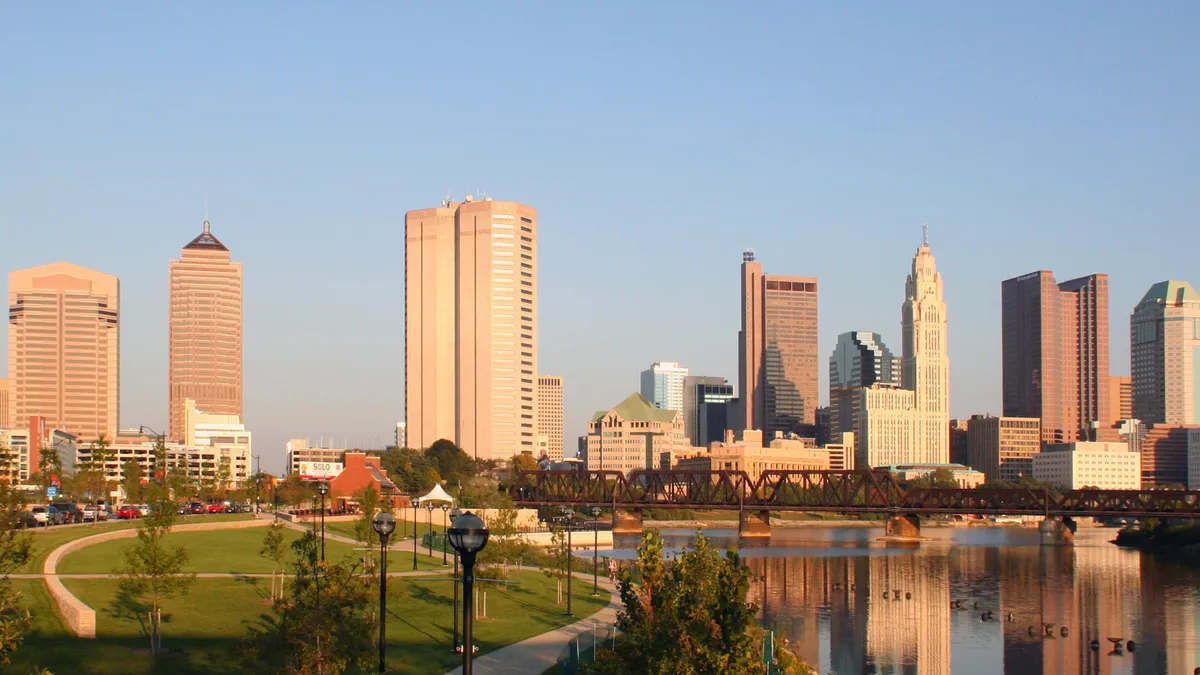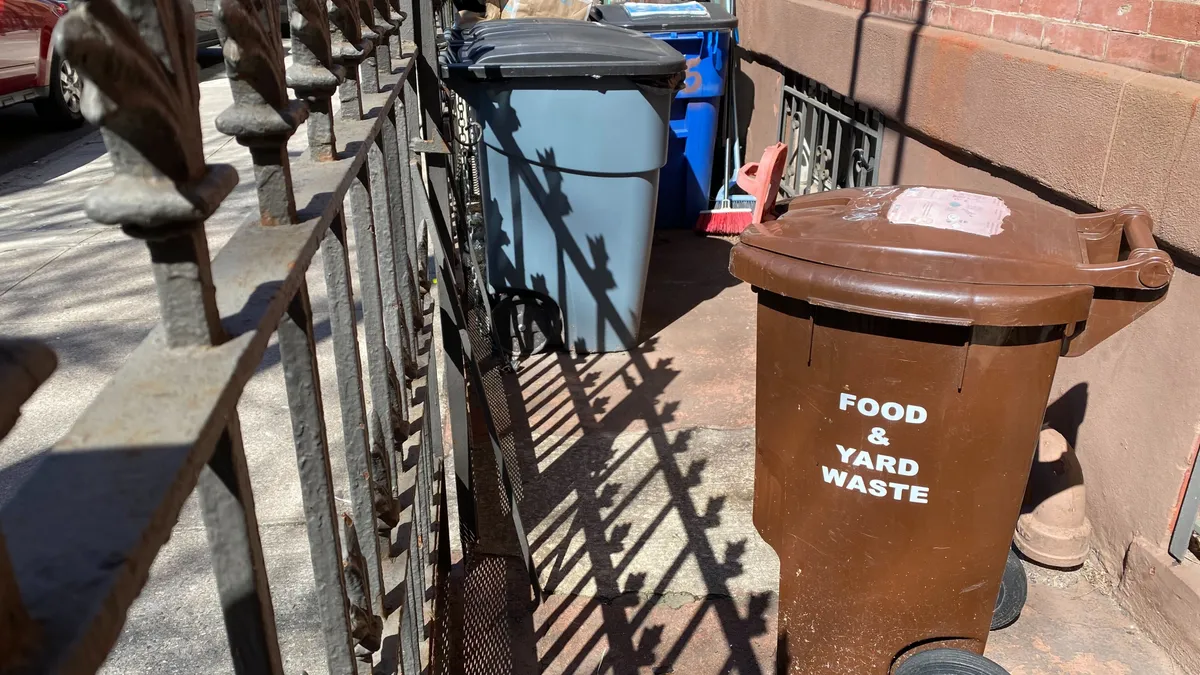Columbus, OH has a storied history of being the nation's test market capital. The Central Ohio region's population has been viewed as a microcosm of the country's demographic, making them ripe for testing the latest hamburgers, ice cream flavors and more recently: smart city technologies.
Columbus Mayor Andrew Ginther has been at the helm of these smart city initiatives, leading the city in its 2016 Smart City Challenge win. Columbus has become a model for smart city success due to its adoption of ambitious climate goals, electric vehicle (EV) technology, community engagement and more.
Mayor Ginther is running unopposed in this year's Nov. 5 mayoral election. Smart Cities Dive caught up with him as part of its coverage tracking the country's upcoming mayoral elections to learn more about the smart city platforms that have shaped his award-winning tenure.
The following interview has been edited for brevity and clarity.
SMART CITIES DIVE: A recent report said Columbus and the surrounding area will grow from 2 million to 3 million residents by 2050. What smart city initiatives are you implementing to help support that projected growth?
ANDREW GINTHER: When we won the Smart City Challenge, we were also awarded a $10 million grant from the Paul G. Allen Family Foundation. That grant was focused on reducing greenhouse emissions by electrifying transportation and decarbonizing our grid. We're really pushing EV adoption with a multifacted effort that includes collaboration with more than 65 of our large employers in the region to educate employees on the benefits of EVs.
Our demographic here in Central Ohio matched up to the nation’s. The thought was that, if we could show EV adoption and growth here in Columbus, you could do it anywhere in the country. Our sales growth in the Columbus region for EVs has now outpaced the U.S. and Midwestern growth rates, making us a leader in EV adoption in the Midwest. Before this award, we were actually lagging behind the country and the region, and now we are outpacing and growing faster than they are. We are excited about the growth that we're going to see in the future.
How do you engage the community in EV adoption and other new smart city initiatives?
GINTHER: It was still difficult for [residents] to see, touch and feel [EVs] so we opened up an experience center. We selected a site accessible for residents to see, touch and drive the technologies of tomorrow. It's got a number of interactive features where visitors can learn how smart mobility will make our community safer and more equitable and more sustainable ... The Smart Columbus team — both the public and private sector — have been housed there with our lead consultants so it's been a pretty incredible place for the public to see the face of this initiative.
I read that you consider climate change to be a social justice issue. Can you expand on that?
GINTHER: What’s the old saying? "It's really expensive to be poor." It shouldn't be more expensive to be comfortable and safe in some neighborhoods versus others. Our office of sustainability's mission is to protect natural resources, implement sustainable practices in the water, sewer and power. And we're going to expand environmental education throughout the city.
Green Spot is a program of ours that inspires, educates and recognizes households, businesses and community groups that adopt green practices. Blueprint Columbus is an innovative way of eliminating sanitary sewer overflows while also investing in our neighborhoods and our local economy. This is some pretty cutting edge green infrastructure work we're doing in neighborhoods to deal with storm water runoff that contributes to those sanitary sewer overflows particularly where combined sewers might be present in the older parts of our city.
I believe this is our responsibility ultimately to make sure we build and lead a community worthy of our children and grandchildren.
What has been one of the biggest challenges for Columbus as your team implements some of these changes and new initiatives?
GINTHER: One of the smartest things we did was engage community action organizations — folks who do organizing and community engagement professionally. Impact Community Action has been our major partner on the energy savers program and has had huge results because they're trusted, credible members of the community that are going door-to-door as opposed to a stranger who may appear as somebody trying to sell something or take advantage of seniors. Having people that are known, credible community leaders, leading that work has been something that's been has made a huge difference.
Columbus has been ranked as one of the most equal metro areas for income equality, but it also tops lists of best places for tech workers to live based on salary and affordability. As more tech workers flock to the city, are there any proactive initiatives you’re taking to prevent the inequalities we’ve seen in tech hubs like the Bay Area or Seattle?
GINTHER: Absolutely. Affordable housing is a major issue. All my great friends who are mayors in Denver, San Francisco, Seattle, Charlotte, NC; Atlanta, and Austin TX, have all seen the type of dramatic and dynamic growth that we're going to see in the next 20 or 30 years. They all have told me, "Get started now. Do not wait."
Two-thirds of our residents are doing better than they've ever done before, but a third of our neighbors have been left out of Columbus' success story and they are struggling to make ends meet. Fifty-four thousand of our residents spend more than 50% on housing. That is not sustainable if we want to protect mixed-income neighborhoods and have safe affordable housing throughout the entire region. It requires us to think differently and act differently. We pride ourselves on public-private partnerships. We think that also should be true for our work around affordable housing so we've engaged our Mid-Ohio regional planning commission to help us with a regional strategy.
The county here raised the conveyance fee on the transfer of property after sale. They are going to dedicate I think $65 million over the next decade. A lot of this work will be guided and aligned with the affordable housing trust fund that we've set up here in the community, and going from a land bank community to a land trust community. The last thing we want to do is build tens of thousands of affordable housing units that we need, to then have a private developer sell them 10-15 years from now. The land trust gives us the ability to make sure that the next tenant or owner of a unit or home [has affordable options] as well.
We want safe and affordable housing available for folks in every neighborhood. We need more market-rate housing in our opportunity neighborhoods and more affordable housing built in our market-ready neighborhoods just so we can protect what's made these neighborhoods. The bottom line is great cities are made up of distinctive neighborhoods.




















